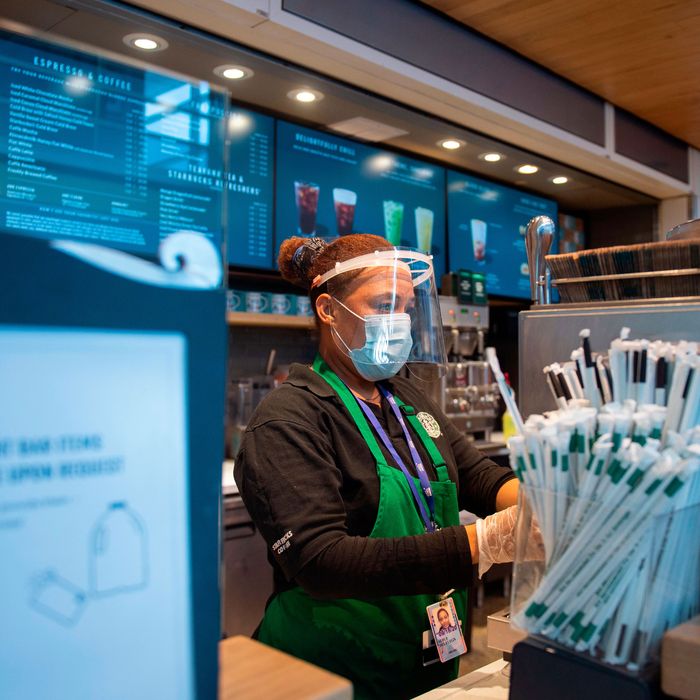
Starbucks did not have a great second quarter, from a financial perspective. There was an obvious reason: Many of its stores were closed for much of the spring due to the pandemic. And there was a less-obvious reason: Many of Starbucks’ usual customers aren’t (or weren’t) going to the office anymore, and that’s caused them to change their coffee-related behavior.
“Disruption to the weekday morning routines — notably, commuting to work and school — is a headwind,” said Starbucks CEO Kevin Johnson, on a call this week when he announced the company’s comparable-store sales in the U.S. were down 40 percent from the same quarter last year. The company did note that light before-work traffic has been somewhat offset by stronger sales in the middle of the day — it seems there are now peaks for Starbucks runs around 9:30 a.m. and again at 2 p.m., which has forced the company to recalibrate its staffing. But a major reason that people weren’t buying as much Starbucks this spring seems to be that people were brewing more coffee at home. And that means Starbucks’ loss was some other companies’ gain.
Back in April, I wrote that J.M. Smucker Co., which makes Folgers, Dunkin’ Donuts, and Cafe Bustelo coffee, was one of the companies performing especially well during the pandemic. That continued to be true at least as of May — the company was selling more coffee, in larger sizes, to more households to brew at home. (Smucker will report results through July in a few weeks.) Makers of home-coffee machines have also been having a good few months. Helen of Troy Ltd., which owns OXO, says that brand was a source of sales growth this spring, as consumers bought more products to use while they stay home, “especially baking, coffee, storage containers and cleaning.”
Newell Brands (which owns a wide variety of consumer product brands including Sharpie, Yankee Candle, and Rubbermaid) reported that sales were down overall in the spring quarter, but up 6 percent in its “appliances and cookware” segment, which includes Mr. Coffee. And Nestlé, which is a major player in the markets for coffee made at home and coffee served in stores, enjoyed modest overall coffee sales growth, with gains in the home channel being offset by losses in the food-service channel. For example, Nestlé makes Starbucks-branded coffee for brewing at home and ready-to-drink Starbucks beverages — these sold well in at-home channels like supermarkets but not so well in food-service channels like Starbucks stores.
Personally, I’m one of the people who bought an OXO coffee maker in the spring quarter. My own coffee-at-home consumption has markedly increased, and I’ve been buying less prepared coffee in shops. The big question for all these companies is how permanent my and other consumers’ shifts will be. My general assumption is that people will mostly be eager to return to their old behaviors once a renormalization of life is feasible. But it’s possible some people who started brewing coffee at home will realize that’s cheaper than buying Starbucks, or easier or tastier than they expected, and that they will keep doing so even after the pandemic is over. Smucker CEO Mark Smucker said on a call with investors in June that over a million customers bought the company’s coffee products for the first time in the quarter that ended April 30, and that the company was developing strategies to keep them as long-term customers.
But the coffee market is already in the process of renormalizing. Starbucks says its U.S. stores that stayed open throughout the pandemic (which typically means locations with drive-thrus) are back to modest positive sales growth. Of course, that still means the company’s U.S. sales are down significantly overall — it says downtown locations have been the slowest to recover, and a small percentage remain closed — but it’s a material improvement from the spring. Dunkin’ Donuts, which reported a drop in same-store sales this spring about half as severe as at Starbucks, says its traffic has already mostly recovered — in the first 25 days of July, same-store sales were down only mid-single digits, a Dunkin’ executive said on that company’s earnings call this week. So these are signs that some of the new coffee machines many Americans bought this spring will sit increasingly unused as consumers return to their prior practice of having somebody else make the coffee.
"drink" - Google News
August 01, 2020 at 12:14AM
https://ift.tt/3hUc8yP
COVID Has Changed How We Drink Coffee - New York Magazine
"drink" - Google News
https://ift.tt/2STbaKe
https://ift.tt/2VWmZ3q
Bagikan Berita Ini














0 Response to "COVID Has Changed How We Drink Coffee - New York Magazine"
Post a Comment